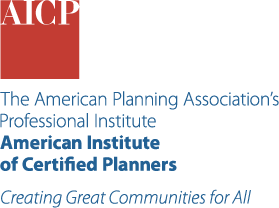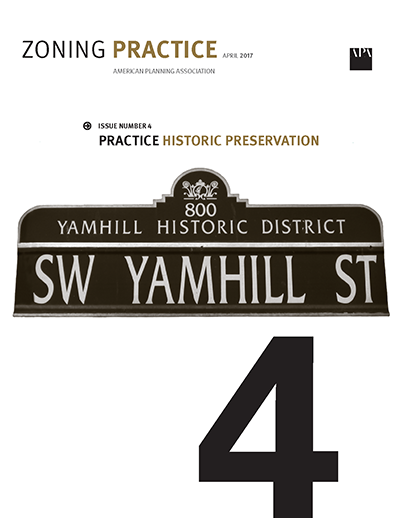Looking for education on this topic?
Check Out Our Passport Courses
Passport is your ticket to the training, experiences, and connections that will take you where you want to go in your planning career. Subscribe for unlimited access for one year to APA's extensive learning library of solution-oriented content facilitated by planners, for planners.
-
Designing an Online Civic Engagement Platform: Balancing “More” vs. “Better” Participation in Complex Public Policymaking
International Journal of E-Politics, 5: 16-40, 2014by: Cynthia Farina, Dmitry Epstein, Josiah HeidtThis article presents a case for basing a new model of civic participation in the theory and practice of democratic deliberation. -
Oregon Comprehensive Land Use Planning Statutes
Revised Statutes §§197 and 197A, Amended 2019These statutes belong to the Accessory Dwelling Units and Planning and Zoning Enabling Laws collections. -
Autonomous Vehicles: Planning for Impacts on Cities and Regions
APA is planning for the impact of autonomous vehicles on our cities and regions. Read a summary of the symposium and find resources on how to plan for AVs now. -
Colorado Springs, CO, Code of Ordinances
Updated September 2024The city’s planning, development, and building code belongs to the Biophilic Planning, Environmentally Sensitive Areas, and Short-Term Residential Rentals collections. -
Jacksonville, FL, Code of Ordinances
2017The city's zoning code was amended in 2015 to allow chicken keeping in certain zoning districts and addresses other livestock as well. -
Residential Infill Development
Residential infill development refers to the development of new housing on vacant or underutilized land in previously developed areas. This collection catalogs resources that provide background information and demonstrate how local and regional entities are using plans and plan implementation mechanisms to guide successful residential infill development. -
Burlington, VT, Code of Ordinances
Updated September 2021These regulations belong to the 13 collections, ranging from Accessory Dwelling Units to Zoning Reform collections. -
San Antonio, TX, Code of Ordinances
Updated July 2023These regulations belong to the Accessory Dwelling Units, Age-Friendly Communities, Food Trucks, Grayfields Reuse and Redevelopment, Green Stormwater Infrastructure, Historic Preservation, Home Occupations, Housing Supply Planning, Inclusionary Housing, Scenic View Protection, Solar Energy, and Tree Preservation and Urban Forest collections. -
Visual Guide to Agrivoltaics and Wildlife-Friendly Solar
by: Alexsandra GomezAgrivoltaics — or the placement of a solar energy system on the same parcel of land as agricultural production — and wildlife-friendly solar practices can help communities capture multiple benefits from large-scale solar development. -
3 Essential Tips for Planning with Multilingual Communities
Community engagement experts offer tested approaches that prevent tokenism, create trust, and foster a sense of belonging.by: Rebecca Greenwald June 09, 2023Community engagement experts offer tested approaches that prevent tokenism, create trust, and foster a sense of belonging. -
Deregulating Parking
by: Grant Holub-MoormanUncovering JAPA: Learn how Champaign, Illinois, has combated onsite parking constraints by removing minimum parking requirements and improving the utilization of existing parking. -
The Compton's Transgender Cultural District
In 2017, San Francisco designated six blocks of the Tenderloin neighborhood as the Compton’s Transgender Cultural District. In the first episode of the podcast series No Small Stories, APA visits the area to learn about how it’s fighting gentrification and displacement and creating a safe, economically productive home for the city's transgender community. -
From Brownfield to Green Space
Wausau, Wisconsin, combined state, federal, and local funding to create a vital new riverfront.by: Meghan StrombergWausau, Wisconsin, combined state, federal, and local funding to create a vital new riverfront. -
Climate-Resilient Pollinator Gardens
PAS QuickNotes 96by: Sagar Shah, PhD, AICPThis edition of PAS QuickNotes explains how planners can use pollinator gardens with native plants to enhance their communities, increase climate resiliency by reducing extreme heat and flooding risks, and achieve the GI goals of protecting natural ecosystems and conserving biodiversity.Nonmember price$0.00APA members & PAS subscribers$0.00 -
Integrating Land Use and Water Planning for a Sustainable Future
Planners and allied professionals should know that when you plan for one, you have to plan for both.by: Heather Hansman July 01, 2021In communities across the U.S., water managers and planners are emerging from the silos they've traditionally operated in to find new ways to work together. The urgency of collaborating to develop resilience in the face of climate change threats is becoming increasingly clear. -
How Can Carshare Help Low-Income Travelers?
by: Grant Holub-MoormanUncovering JAPA: Carshare programs can benefit low-income travelers but there remain some challenges that need to be addressed. -
Protecting Value Through Historic Preservation Regulations
Zoning Practice — April 2017by: Lane Kendig April 01, 2017This issue of Zoning Practice discusses how careful planning and drafting of zoning standards can help mitigate landowner concerns while advancing historic preservation goals. It covers both district-based and scattered-site approaches to historic preservation regulations.List Price$10.00ZP subscriber$0.00 -
Rural Communities Embrace ADUs to Boost Housing Supply
How planners, lawmakers, and residents are changing attitudes and zoning rules about accessory dwelling units in small towns.by: Kevin HardyHow planners, lawmakers, and residents are changing attitudes and zoning rules about accessory dwelling units in small towns. -
Managing Shared-Use Micromobility
PAS QuickNotes 86by: Alexsandra Gomez June 01, 2020This edition of PAS QuickNotes defines shared-use micromobility and highlights key considerations for planners and officials to ensure that its implementation supports community goals and provides reliable local transportation options for all.Nonmember price$10.00APA member & PAS subscriber$0.00 -
Planning for Biophilic Cities
PAS Report 602by: James Brown, Helen Santiago Fink October 01, 2022A biophilic city connects the science of biophilia — humans’ innate love of and need for contact with nature — and the practice of planning to create built environments that support physical and mental well-being, ecosystem health, and economic sustainability.Nonmembers$25.00APA members & PAS subscribers$0.00 -
Harvesting Benefits from Incentive Zoning
Zoning Practice — May 2025This issue of Zoning Practice explores how incentive-based zoning has evolved over the decades to become an increasingly effective tool in helping communities reach their planning goals and community vision. It begins with an overview of the origins and evolution of incentive-based zoning in the U.S. before presenting a modern, three-pronged approach. -
Examining Food Systems and Sovereignty In Conflict Cities
by: Jessica ShakesprereUncovering JAPA: Future planners should be prepared for the politics of planning, especially the challenging role of planning in conflict cities aiming to protect food systems. -
Empowering the Next Generation of Planners
by: Dina WaltersEquity In Practice: In Boston, a collaborative effort is empowering diverse youth to pursue careers in urban planning and create positive community impact. -
Can Transit-Oriented Developments Include Affordable Development?
by: Grant Holub-MoormanUncovering JAPA: Explore hurdles to affordable housing in Southern California's transit-oriented developments, and the importance of legislative and local government support for inclusivity in transit communities. -
Will We Zone For Transit?
by: Grant Holub-MoormanUncovering JAPA: Explore how transit-oriented development (TOD) emerged as a crucial strategy in curbing urban sprawl with the 2023 Montreal light rail project. -
The Commissioner — February 2016
In this PDF of The Commissioner's February 2016 issue: "Planning with Large Institutions," "Using Planning Data Wisely (Part Two)," "Zoning with Stipulations," a short history of wayfinding, and a resource finder on working with institutions.List price$85.00Members & subscribers$0.00 -
Columbus 'Zones In' on More Housing Amid Population Boom
by: Jon DePaolisThe effects of the nationwide housing supply crisis were pushing Columbus, Ohio, to the brink. -
Five Ways to Plan for More Accessible Housing
At least 25 percent of U.S. residents will experience a disability that impacts their daily life. How can we better prepare America's housing stock?November 01, 2020Here are five best practices and tools to help planners support move-in-ready accessible housing. -
Rewriting the Urban Planning Canon
February 01, 2020A planning education that focuses solely on a few predominantly white heroic figures is incomplete and unethical. -
Climate Change Pushes Fair Bluff to Higher Ground
How a North Carolina town, a tribal community, and others are rising from climate-caused ruin to create new beginnings.by: Joe Tedino September 24, 2024How a North Carolina town, a tribal community, and others are rising from climate-caused ruin to create new beginnings. -
Rethinking the Way We Do Green Urbanism
January 01, 2018Planning for a new bridge park in Washington, D.C., aims to minimize negative impacts such as displacement and gentrification. -
Maximizing Affordable Housing Production Under Inclusionary Zoning
by: Noah LevineUncovering JAPA: Authors aim to understand the effectiveness of different inclusionary zoning policies. -
Activating Communities Using Pop-Up Designs
Planning Approaches to Encourage Physical Activity in Small and Rural Communitiesby: Johamary Pena, AICP, Sagar Shah, PhD, AICPThis blog post provides an overview of pop-up designs and activations as a planning approach to increase physical activity in small and rural communities through everyday destinations. It is part of the Everyday Destinations series. -
Henderson, NV, Development Code
Updated July 2019The city's development code belongs to the Group Housing, Marijuana-Related Uses, and Solar Energy collections. -
Louisville-Jefferson County, KY, Land Development Code
Updated July 2018This regulation belongs to the Active Transportation, Form-Based Zoning, Outdoor Lighting, and Short-Term Residential Rentals collections. -
Savannah, GA, Code of Ordinances
Updated October 2019This regulation belongs to the Green Stormwater Infrastructure, Historic Preservation, and Urban Livestock collections. -
Birmingham, AL, Comprehensive Plan
Adopted October 2013This city's comprehensive plan belongs to the Age-Friendly Communities, Capital Improvements Programming, Community Visioning, Comprehensive Planning, and Green Building collections. -
Lowell, MA, Sustainable Lowell 2025
Adopted 2013This city's comprehensive plan belongs to the Built Environment and Health, Community Visioning, Comprehensive Planning, Social Equity, and Solar Energy collections. -
Troy, MI, Zoning Ordinance
Updated March 2023These regulations belong to the Green Building, Solar Energy, Wind Energy, and Zoning Reform and Code Writing collections. -
New Orleans, LA, Comprehensive Zoning Ordinance
Updated 2019This regulation belongs to the Environmentally Sensitive Areas, Food Trucks, Historic Preservation, Short-Term Residential Rentals, and Zoning Reform and Code Writing collections. -
Memphis-Shelby County, TN, Unified Development Code
Adopted August 2010This regulation belongs to the Outdoor Lighting, Urban Agriculture, Urban Livestock, and Zoning Reform and Code Writing collections. -
Portsmouth, VA, Code of Ordinances
Updated July 2019This regulation belongs to the Active Transportation, Green Building, Solar Energy, and Zoning Reform and Code Writing collections. -
Milwaukee, WI, Code of Ordinances
Updated November 2019These regulations belong to the Complete Streets, Green Stormwater Infrastructure, Rethinking Off-Street Parking Requirements, Solar Energy, and Urban Livestock collections. -
Rochester, NY, City Code
Updated July 2018The city's zoning code belongs to the Downtown Revitalization, Form-Based Zoning, Rethinking Off-Street Parking Requirements, and Solar Energy collections. -
Bloomington, MN, Code of Ordinances
Updated December 2019This regulation belongs to the Accessory Dwelling Units, Active Transportation, Affordable Housing Programs, Creative Placemaking, Green Building, and Housing Supply Planning collections. -
Seattle, WA, Seattle 2035
Updated December 2018This comprehensive plan belongs to the Affordable Housing Programs, Age-Friendly Communities, Creative Placemaking, Environmentally Sensitive Areas, Housing Supply Planning, Neighborhood Planning, and Social Equity collections. -
Hailey, ID, Municipal Code
Updated October 2022This regulation belongs to the Accessory Dwelling Units, Green Building, Housing Supply Planning, Outdoor Lighting, Solar Energy, Tiny Homes and Micro Apartments, and Urban Livestock collections. -
Gainesville, FL, Code of Ordinances
Updated May 2022This regulation belongs to the Accessory Dwelling Units, Biophilic Planning, Green Building, Housing Supply Planning, Outdoor Lighting, Shared Mobility, and Wildland-Urban Interface collections. -
Decatur, GA, Code of Ordinances
Updated November 2024These regulations belong to the Accessory Dwelling Units, Food Systems, Housing Supply Planning, Tree Preservation and the Urban Forest, Urban Agriculture, and Zoning Reform and Code Writing collections. -
Environmentally Sensitive Areas
Environmentally sensitive areas (ESAs) are environmental features that are susceptible to adverse impacts from new development. This collection catalogs resources that provide background, policy guidance, or examples of local plans and regulations aimed at protecting environmentally sensitive areas.












